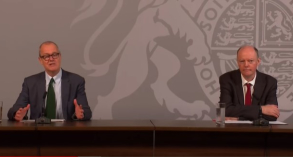Covid-19 update: 25 September
The week began with a sobering press briefing from the government’s chief scientific adviser, Sir Patrick Vallance, and chief medical officer, Chris Whitty (pictured below). Professor Whitty said the country had turned ‘a corner in a bad sense’ and Sir Patrick said that, if the current trend of the epidemic doubling every seven days continued, there could be as many as 50,000 cases per day by the middle of October. And this might be expected to lead to 200 deaths a day just a month later.
Hospitalisations have been steadily rising since the beginning of September – with new Covid-19 inpatient cases in England standing at around 200.
With cases rising rapidly, the UK’s Covid alert level was raised from level 3 to level 4 on the back of a recommendation from the chief medical officers for all four UK nations. Level 4 reflects that the epidemic is in general circulation, transmission is high or rising exponentially.
This paved the way for prime minister Boris Johnson to impose a series of measures in an attempt to curb the number of daily infections and reduce the reproduction rate. The most recent (25 September) official figures put this R number at between 1.2 and 1.5. However the latest results from research by Imperial College London as part of the Real-time Assessment of Community Transmission (React) programme suggest this could have been as high as 1.7 at the beginning of the month.
The new measures include requiring all hospitality venues to close at 10pm, asking people to work from home where possible and extending the face covering requirement to all staff in retail. New rules will be accompanied by tougher penalties and will be policed more closely. While Mr Johnson said the measures stopped short of a full lockdown, more drastic action would be taken if necessary. This was followed on Thursday by the launch of a new job support scheme to replace the current furlough arrangements.
There were some concerns that the government advisers had overstated the rate of increase of the virus – and that their own graph to demonstrate one possible virus pathway did not bear out the claim of doubling every seven days. Economist and presenter of Radio 4’s More or less statistics programme told the Today programme that problems with the testing programme meant that this was a poor source to test the argument. However, he said that figures from the Office for National Statistics’ weekly infection survey, and separate numbers for hospitalisations, both suggested that the advisers’ claim was ‘not far off’. For example, ONS figures show there were 36 new infections per million per day in late August, rising to 58 and then 110 over the next two weeks.
However in his statement to the House of Commons on Tuesday, the prime minister was less specific, stating that that the doubling rate for new cases could be between seven and 20 days. In Scotland, with an estimated R number between 1.2 and 1.6, latest data suggests the doubling time is between 8.4 and 15.4 days.
In prime minister’s questions, Labour leader Sir Keir Starmer challenged Mr Johnson to identify the cause of current problems with the testing programme – problems the prime minister acknowledged at the previous week’s Commons Liaison Committee. Was it the lack of capacity – ‘the Dido Harding defence’? ‘Or is it that we have all the capacity we need, it is just that people are being unreasonable in asking for tests? That is the [Matt] Hancock defence,’ he asked.
The prime minister responded by asking the opposition leader to back the NHS Test and Trace service and restated the target to increase daily testing to 500,000 by the end of October – more than doubling current levels of pillar 1 and 2 testing, which was only 30,000 tests off capacity according to latest figures reported on Thursday.
(For anyone confused by the various claims and counter-claims for the number of tests being undertaken, and the differences between this number and both the number of people newly tested each day and the testing capacity – fact checking service Full Fact has provided a handy explainer.)
In a blog this week, NHS Providers chief executive Chris Hopson said there should be sympathy and understanding for those who had to create NHS Test and Trace from scratch in a hurry. And there should be recognition that the country is now testing more people per head than France, Spain and Germany. But some government decisions hadn’t helped.
Mistakes included taking too long to establish the service, getting side-tracked chasing an end-of-April capacity target and then trying to persuade people they’d met it. Promising a ‘world class service’ by the end of June was also unhelpful, shooting the service in the foot ‘just as it was leaving the starting blocks’.
‘We’ve also had too much government bombast, bluster and bluff for too long,’ said Mr Hopson. ‘The bombast of pointing to the total number of tests undertaken over the last seven months because it’s a big sounding number. The bluster of dismissing thousands of people’s recent experience of being unable to get a test as “carping”. The bluff of pretending that all will be well in a 10 million tests a day “moonshot” next year.’
The latest report from the NHS Test and Trace service again made for difficult reading. It clearly underlined the concerns about the spread of the virus, reporting that 19,278 new people had tested positive for coronavirus in England in the week to 16 September. This was an increase of around 900 or 5% compared with the previous week – based on a similar number of tests – but almost three times the numbers at the end of August.
Median turnaround times for in-person tests in the community (pillar 2) increased again and there were further reductions in the proportion of tests turned around within 24 hours.
On contact tracing, of the 21,268 people transferred to the system, 78% were reached and 84% of these provided details of one or more close contacts. Some 75% of these were reached and asked to self-isolate.
NHS Providers deputy chief executive, Saffron Cordery said the significant increase in positive cases was ‘deeply worrying’. ‘With demand for tests rising, there is a negative knock on effect on turnaround times, with only about half of people getting a result back in 24 hours,’ she said. ‘In practical terms, this is impacting people’s ability to get back to work or school and wider public confidence in the system.’
However she was encouraged by the 37% increase in the number of people transferred into the tracing system and said that everyone had a part to play in enabling Test and Trace to deliver, especially with winter on the way.
Billy Palmer (pictured), senior research fellow at the Nuffield Trust, acknowledged that other countries were also struggling to put effective track and trace in place. However, the English service was ‘a far cry from watertight’. ‘Large numbers of contacts are still being missed and information such as how many people actually go on to self-isolate is still missing, hampering our understanding of the spread of the virus.
He added that the launch of the Covid app across England and Wales could be a significant moment – but needed to work effectively with the manual contact tracing service.
Echoing these comments, Layla McCay, NHS Confederation director, said she hoped the app would improve the efficiency with which people can be reached and asked to self-isolate. But again she stressed: ‘Access to testing must be improved alongside increased tracing capacity. It doesn’t matter how many hundreds of thousands of tests are technically available if the people who need them can’t access them.’
The much-delayed, new NHS Covid-19 app for England and Wales was launched on Thursday. Features include contact tracing using Bluetooth, risk alerts based on postcode district, QR check-in at venues, symptom checking and test booking. For contact tracing, if someone chooses to share (anonymously) that they have tested positive for the virus, the app will send an alert to other app users that have been in close contact with them over the last few days.
By Thursday afternoon, one million people had downloaded the app although there were some complaints that it was not compatible with older smartphones.
The impact of the virus on NHS staff was also in the spotlight this week. Figures from NHS Digital showed that nearly one in five absences recorded in May were related to Covid-19 – costing the NHS 340,900 full-time equivalent (FTE) days. NHS Employers said the figures showed that in March, April and May, NHS staff lost a total of more than 1.3 million FTE days due to Covid-19.
NHS Providers director of policy and strategy, Miriam Deakin (pictured), said it was not clear from the figures how many of the absences were avoidable. ‘In the absence of regular routine testing for staff and patients, with fast turnaround times, this was clearly a problem early in the summer, and it remains a problem today,’ she added.
A report from the King’s Fund said that staff stress, absenteeism, turnover and intentions to quit had already reached alarmingly high levels before Covid-19. However, the pandemic has exacerbated problems faced by nurses and midwives, including inequalities, inadequate working conditions and chronic excessive work pressures. The report made a number of recommendations, including introducing minimum standards for facilities and working conditions, developing multidisciplinary teamworking, and tackling ‘chronic excessive work demands’.
In a separate report on workforce statistics, NHS Digital showed that hospital and community health service staff numbers grew by 8,635 FTEs between May and June, compared with just 1,075 in the same period the year before. The bulk of these – 5,197 – were categorised as support to doctors, nurses and midwives and appear to reflect the numbers of student nurses brought in to support providers during the Covid response.
This snapshot in June showed that the NHS in England had added more than 14,000 nurses and more than 9,000 doctors since the year before. And health secretary Matt Hancock said that, with a 23% rise in people accepting places on nursing courses in England, the government was ‘well on our way to delivering 50,000 more nurses by the end of this Parliament’.
However the Commons Public Accounts Committee this week said that the pace of progress was too slow and that the government still did not have a detailed understanding of nursing needs. The committee’s report called for a set of costed and detailed action plans for each of the different supply routes for nursing and how many nurses each route is expected to contribute.
Related content
The value masterclass shares examples of organisations and systems that have pursued a value-driven approach and the results they have achieved.
This webinar series offers colleagues of ICS organisations the opportunity to discuss common priorities, challenges, and successes within their field.